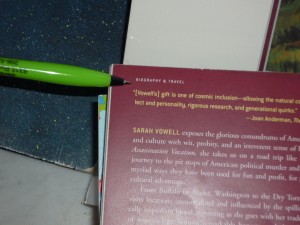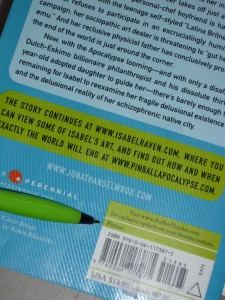Here’s the promised word, New Year’s resolvers: don’t.
Oh, I don’t mean to give up on your estimable resolve to put in the work to land an agent this year, or even to send out queries on a regular basis to any agent at all likely to be interested in representing a book like yours. That’s all quite sensible: if your goal is to land an agent, working up the nerve to query is in fact a necessary step. (Either that, or you are going to have to work up the even greater nerve and financial resources required to pitch at a writers’ conference.) Go forth and query, with my blessings.
Nor would I even dream of dissuading those of you who, having queried or pitched successfully in the past six months or so, have decided that it’s about time that you stopped revising feverishly, screwed your courage to the sticking place, as Shakespeare would have it, and try your luck with the agent(s) that requested manuscript pages. Again, this is a sensible, requisite step to getting published: since no agent in her right mind would sign a writer without having read any of her work — contrary to popular opinion amongst pitchers and queriers — obviously, if you want an agent to offer to represent you, you are going to have to let her read the manuscript in question.
I’ll even stretch the point further: since the only manuscript that has absolutely no chance of getting published or landing an agent is the one that just sits in a drawer or on a hard drive, without the writer’s ever exposing it to professional scrutiny — something that requires quite a bit of guts, by the way; queriers and submitters don’t give themselves enough credit for that — I would actively applaud your efforts to get your work under professional eyeballs.
I just would advise against doing it anytime within the first three weeks of the year. The first three weeks of any year.
Why? Look to your left in those starter’s blocks, New Year’s resolvers, and to your right: you’ll find aspiring writers who made precisely the same New Year’s resolution you did. And since the whole point of a New Year’s resolution is that the resolver puts it in motion practically as soon as that shiny ball drops into Times Square, what do you think happens around this time every year?
That’s right, campers: pretty much every agency in the country gets swamped with queries — and with the submissions that the agency requested months ago.
How swamped, you ask, turning pale with horror? Well, let me put it this way: I usually run a caution about this on December 31 — or, at the latest, January 1. Since some of my readers chafed at the bit last year, insisting that my advice was delaying their querying efforts unnecessarily, my New Year’s resolution was that in 2012, I would not issue my yearly warning about the dangers of joining the annual early January lemming run until I had observed another annual phenomenon: the barrage of wondering complaints from people who work in agencies about why their mail bags are suddenly thrice as heavy. At agencies that accept e-mailed queries, inbox input roughly quadruples.
I heard the first of those complaints today. It’s January third — and in the U.S., post offices were closed yesterday.
Not sure why? Okay, here’s a pop quiz for those of you who spent some or all of the recent holiday season hobnobbing with kith and/or kin who happened to be aspiring writers: hands up if you bumped into at least one who confided that that her New Year’s resolution was to get those long-delayed queries out the door, preferably within the first two weeks of January. Raise a hand, too, if a friendly soul astonished you by swearing that come January 1, that postponed-for-months submission was finally going to be making its way to the agent who requested it. Or that this was the year that novel was going to make its way out of that drawer and onto bookshelves everywhere.
And don’t even dream of dropping those hands if you know — or are — a writer who is spending today, or this coming weekend, cranking out query letters so they can go out in Monday morning’s mail. Or sending e-mails to arrive even faster.
Okay, legions with your hands in the air: keep ‘em up if you had ever heard these same writers make similar assertions before. Like, say, December of 2010, 2009, 2008, 2007, or any year before that.
I’m guessing that very few of you dropped your hands. Starting to get the picture, are we?
Unless some of you wanted to ask a question? Yes, eager beavers? “But Anne,” those of you who have already sent out a query, two, or seventeen this year protest, “what’s wrong with that? Because there are so many people who want to get published, well-established agents at reputable agencies are constantly overwhelmed with queries, aren’t they?”
Before I answer that, beavers, was that giant sucking sound I just heard an indication that some of you who are new to Author! Author! — perhaps reading it for the first time as the result of a highly laudable New Year’s resolution to learn more about marketing your writing — were unaware that typically, agents are not the ones screening queries, or even submissions? As nice as it might be for agents to cast their eyes over every query and submission personally, a successful agent simply doesn’t have the time. In order to get through the monumental volume of queries and make sure the agent has the time to read requested materials that have made it past the first cut, agencies employ professional readers like Millicent, the fortunate soul charged with opening all of those query letters and giving a first read to requested materials, to weed out the ones that her boss the agent will not be interested in seeing, based upon pre-set criteria.
At some agencies, a submission may even need to make it past two or three Millicents before it lands on the actual agent’s desk. That way, the agent can concentrate upon what actually supports the agency, selling already-signed clients’ work.
If any or all of that seems like an oddly disrespectful way to treat the Great American Novel, let’s get practical for a moment: a reasonably well-respected agent might receive in the neighborhood of 1200 queries in any given week — and you can triple or quadruple that this time of year. If Millicent’s boss wants to see even 1% of the manuscripts or book proposals being queried, that’s 10 partial or full manuscripts requested per week. Of those, perhaps one or two will make it to the agent.
Why so few? Well, even very high-volume agencies don’t add all that many clients in any given year — particularly in times like these, when book sales are, to put it generously, slow. Since that reasonably well-respected agent will by definition already be representing clients — that’s how one garners respect in her biz, right? — she may be looking to pick up only 3 or 4 clients this year.
Take nice, deep breaths, campers. That dizzy feeling will pass before you know it.
Given the length of those odds, how likely is any given submission to make it? You do the math: 10 submissions per week x 52 weeks per year = 520 manuscripts. If the agent asks to see even the first 50 pages of each, that’s 26,000 pages of text. That’s a lot of reading — and that’s not even counting the tens of thousands of pages of queries the agency needs to process as well, all long before the agent makes a penny off any of them, manuscripts from current clients, and everything an agent needs to read to keep up with what’s selling these days.
See where a Millicent might come in handy to screen some of those pages for you? Or all of your queries?
Yes, I know that this is a lot for those of you brand-new to the process to absorb. Keep taking those nice, deep breaths.
“While we’re waiting for those new to the game to recover,” my previous questioners ask impatiently, “can we get back to my question? No matter how many queries might stack up in the early weeks of the year, Millicent will just answer them in the order received, right? Ditto with any backlog of queries that might have come in while she was home for the holidays. So it might take a little longer for me to hear back; big deal.”
Actually, timing in sending a query or submission is a big deal, beavers of eagerness. It’s not as though agencies typically hire additional staff to handle the January onslaught, any more than they call in temps to deal with the increased querying and submission volume immediately after Labor Day, Memorial Day, or any federally-mandated three-day weekend. So our old pal Millicent is faced with a radically increased workload, but the same amount of time with which to deal with it.
I appeal to your sense of probability, campers: if you were Millicent, would you be more likely than usual to reject any given query in that morass, knowing that you had another 10,000 to read, or less? Would you be more inclined to turn from page 1 to page 2 in that submission in front of you or less?
I have an even better question: why on earth do aspiring writers do this to themselves every year?
The scourge of the New Year’s resolution, that’s why. Despite the fact that we’ve all spent our entire lives watching people make and break these resolutions, social conditioning (and, let’s face it, a hefty proportion of media outlets) encourages us to believe that it’s inherently easier to begin a new project on January 1 — or at any rate, in January — than at any other point of the year.
We buy this, interestingly, even though our bodies tell us the opposite, Not only are people exhausted from the holidays, but in January, not even the sun appears to interested in doing its job with any particular vim.
Yet millions of aspiring writers all across North America are going to spent yesterday, today, tomorrow, and the next few weeks rushing those queries into envelopes, hitting those SEND buttons, and forcing themselves to sit in front of a keyboard at a particular time each day. Successful queriers and pitchers of months past will also be springing into action, feverishly printing out or e-mailing requested materials. And every single one of these fine, well-intentioned people will feel downright virtuous while engaging in this flurry of feverish early January activity.
Again: nothing wrong with that. The problem is, a good third of the aspiring writers in North America will be embracing precisely the same temporally-limited version of virtue.
The predictable, inevitable, and strategically unfortunate result: for the first three weeks of January every year, agencies across the land are positively buried in paper. Which means, equally predictably, inevitably, and unfortunately, that a query or manuscript submitted right now stands a statistically higher chance of getting rejected than those submitted at other times of the year.
Oh, I completely understand the impulse to rush those queries out the door, especially for aspiring writers whose last spate of marketing was quite some time ago. Last January, for instance, immediately after their last set of New Year’s resolutions.
I don’t say that to be judgmental: it can be genuinely difficult to work up the momentum to try, try again. Plenty of queriers and submitters take some time to lick their wounds after their last set of rejections — or, as is getting more and more common, their last round of sending out a query or even requested materials, waiting patiently, and just never hearing back. If a writer has pinned all of his hopes on a particular agent’s falling in love with his writing (or, in the case of a query, with his book concept; contrary to popular opinion, it’s logically impossible for a manuscript’s writing style to get rejected by an agent who has seen nothing but a query letter), selecting an arbitrary date to pick himself up, dust himself off, and move on to the next agent on his list is not the worst of ideas.
But why must that much-anticipated day be just after the New Year — instead of, say, the far more practical February 1? Or on the Wednesday following any long weekend, rather than on Saturday, Sunday, or Monday, when everyone else will be diligently stuffing Millicent’s e-mail inbox to overflowing?
Yes, yes, I know: weekends are when a lot of writers have the time to query, and the holidays are actually quite a sensible time for even queriers who send out those letters like clockwork to take a breather. That last is particularly true: although the NYC-based publishing industry does not shut down as completely between Thanksgiving and New Year’s Day as in years past, things still do slow down. So many of the fine people who work within it on vacation and/or celebrating various holidays, it just doesn’t make sense to query or submit then. Your missive might reach a Bob Cratchit working late on a holiday eve, but frankly, even ol’ Bob tends not to screen his e-mail very closely over the holidays.
So I have nothing but sympathy for those of you who are trying to get back into the swing of querying and submitting. Just like every other kind of writing, it’s easier to maintain momentum if one is doing it on a regular basis than to ramp up again after a break. Just ask anyone who has taken six months off from querying: keeping half a dozen permanently in circulation requires substantially less effort than starting from scratch — or starting again.
Blame it on the principle of inertia. As Sir Isaac Newton pointed out so long ago, an object at rest tends to remain at rest and one in motion tends to remain in motion unless some other force acts upon it. For an arrow flying through the air, the slowing force is gravity; for writers at holiday time, it’s often friends, relatives, and sundry other well-wishers. And throughout the rest of the year, it’s, well, life.
But you’re having trouble paying attention to my ruminations on physics, aren’t you? Your mind keeps wandering back to that earlier boldfaced pronouncement like some poor, bruised ghost compulsively revisiting the site of its last living moment. “Um, Anne?” those of you about to sneak off to the post office, stacks of queries in hand, ask with quavering voices. “You were just kidding about that whole statistically more likely to be rejected thing, right? I thought that good writing was always welcomed, whenever it arrived at an agency. Or, to vent my feelings a trifle more adequately, mind if I scream in terror, ‘How could a caring universe do this to me?’
At the risk of making those of you new to the game hyperventilate, I’m going to ask those readers who followed last autumn’s Queryfest to chant the answer along with me: with any query or submission, an agent must weigh more factors than the quality of the writing. Because agencies are profit-seeking entities, not charitable institutions devoted to the promotion of literature (as much as writers might like them to be the latter), she can only afford to take on manuscripts and book proposals she is relatively certain she can sell in the current literary market.
That means, in practice, that plenty of good writing and good book concepts get rejected. And that in considering which queries and submissions her boss is likely to wish to represent, Millicent has to look not only for good writing, but book category-appropriate voice and storyline, appeal to readers already buying similar books, freshness of book concept, and many, many other factors.
Including — and here is where the statistical probability thing rears its ugly head — the sheer volume of queries and submissions.
Millicent, then, has a rather different job than one might expect: she is charged with weeding out as many of those queries and submissions as possible, rather than (as the vast majority of aspiring writers assume) glancing over each and saying from time to time, “Oh, the writing here’s pretty good. Let’s represent this.” If she did that, her boss might end up with several hundred submissions to read in any given week. Clearly, that’s just not logistically possible. Fortunately for Millicent, most submissions, and definitely most queries, contain problems that render them fairly easy to reject — or have simply ended up in an agency that does not represent the kind of book in question.
A good writer should be happy about that, actually. Since Millie’s desk is perpetually covered with queries and submissions, the more quickly she can decide which may be excluded immediately, the more time she may devote to those that deserve a close reading.
Given the imperative to plow through all of those queries and submissions with dispatch, is it a wonder that over time, she might develop some knee-jerk responses to certain very common problems that plague many a page 1? Or that she would gain a sense (or even be handed a list) of her boss’ pet peeves, so she may reject manuscripts that contain them right off the bat? As in on page 1 — which is where, incidentally, the vast majority of submissions get rejected — or within the first paragraph of a query letter?
Now, the volume of queries and submissions conducive to this attitude arrive in a normal week. However, as long-term habitués of this blog (or even close readers of this particular post) are already no doubt already aware, certain times of the year see heavier volumes of both queries and submissions of long-requested materials than others.
Far and away the most popular of all: just after New Year’s Day.
Why, I was just talking about that, wasn’t I? That’s not entirely coincidental: this year, like every year, Millicent’s desk will be piled to the top of her cubicle walls with new mail for weeks, and her e-mail inbox will refill itself constantly like some mythical horn of plenty because — feel free to sing along at home — a hefty proportion of the aspiring writers of the English-speaking world have stared into mirrors on New Year’s eve and declared, “This year, I’m going to send out ten queries a week!” and/or “I’m going to get those materials that agent requested last July mailed on January 4!”
Again, I have nothing against these quite laudable goals — although a goal of ten queries per week would be hard to maintain for many weeks on end, if an aspiring writer were targeting only agents who represented his type of book. (And everybody is aware that querying agents who don’t have a proven, recent track record of selling similar books is a waste of an aspiring writer’s valuable time, energy, and emotion, right?) My only concern is that you implement those goals in a manner that is likely to get the results you want, rather than merely leaving you discouraged before Martin Luther King, Jr., Day rolls around.
Which is, incidentally, the fate of most New Year’s resolutions. Had I mentioned that the average one lasts less than three weeks?
Let’s try to imagine what it would be like to be Millicent during those three weeks, before all of those poor revisers run out of steam. If you were a screener who walked into work, possibly a bit late and clutching a latte because it’s a cold morning, and found 700 queries instead of the usual 200, or 50 submissions rather than the usual 5, would you be more likely to implement those knee-jerk rejection criteria, or less?
Uh-huh. Our Millicent’s readings tend to be just a touch crankier than usual this time of year. Let her dig her way out from under that mountain of papers before she reads yours; she’ll be in a better mood.
Ditto with Monday mornings — and not just for the reason that most people who work a Monday-Friday week are grumpy then. All weekend long, busy queriers and submitters have been toiling away like unusually dedicated ants, filling her e-mail inbox to bursting with messages; regular mail also arrived on Saturday. So the next few Mondays — particularly the coming one, if she has been on vacation — will see her frantically trying to clear out that inbox and read through what’s on her desk as quickly as humanly possible.
Again, do you think that will make her more likely to reject any individual query or submission in that pile, or less?
For this reason, if you feel you absolutely must query or submit via e-mail during the next month, avoid doing it on either a Monday, Friday, or a weekend. Actually, that’s not a bad rule of thumb for e-querying and e-submitting in general: January is not the only time when most aspiring writers have more time on the weekends than mid-week.
Some of you have had your hands in the air for the last three paragraphs, have you not? “But Anne,” those of you chomping at the bit ask, “if you’re advising me against taking action now, when can I reasonably begin querying or sending off that requested manuscript? Martin Luther King, Jr., Day? I have a long weekend then.”
Well, that wouldn’t be a bad choice to start stamping those SASEs — although, like after holiday weekend, Millicent’s inbox will be stuffed to the proverbial gills on the morning of Tuesday, January 17. It would be fair to expect queries and submissions tend to drop off thereafter, though. Yes, that would make quite a bit of sense.
So, you may well be wondering, why am I urging every aspiring writer within the sound of my voice to hold off until February 1?
Two reasons. First, over the past few years, the statistics about how many electronic readers and e-books sold over the holidays, vs. the number of traditionally-published books, have tended to come out around mid-January. (Oh, a few estimates will be available before then — there are probably some figures out now — but it usually takes a few weeks to verify the actual totals.) This year, the news is likely to depress folks who work in traditional publishing.
Yes, even more than last year. As you may have heard, 2009 was the first year that e-books outsold hard copies at Amazon on Christmas. Those sales figures were just for Christmas Day itself, an occasion when, correct me if I’m wrong, folks who had just received a Kindle as a present might be slightly more likely to download books than, say, the day before.
But that’s not what the headlines screamed immediately afterward, was it? I assure you, every agency and publishing house employee in North America spent the intervening days fending off kith and kin helpfully showing him articles mournfully declaring that the physical book is on the endangered species list. Or ought to be.
It’s probably safe to assume that this year’s mid-January statistics will not leave the denizens of agencies and publishing houses very happy. Or receiving any fewer calls from kith and kin, once again predicting the demise of the publishing industry, despite the fact that book sales for both e-books and traditional books have been on the rise lately.
Now, naysayers have regularly predicted the imminent death of the publishing industry every year since the mid-19th century, but that doesn’t make it any easier to hear, does it? Tell me, if you were Millicent and kept hearing all of those harbingers of doom, how cheerful would you be when screening?
She’s been hearing dismal prognostications as often as the rest of us — and she’ll probably be hearing even more once those statistics come out. When she steps across the agency threshold the next day, too-hot latte clutched in her bemittened hand, the Millicent in the cubicle next to hers will be complaining about how his (hey, Millicents come in both sexes) kith and kin has been cheerfully informing him that he will be out of a job soon. So will half the people who work in the agency — including, as likely as not, Millicent’s boss.
It’s only reasonable to expect, of course, that through the magic of group hypnosis, the more everyone repeats it, the more of a threat the news will seem; the scarier the threat, the more dire the predictions of the future of publishing will become. By lunchtime, half the office will be surreptitiously working on its resumes — yet another annual phenomenon.
Given the ambient mood in the office, do you really want yours to be the first query she reads that day? Or the fiftieth? Or would you rather that your precious book concept or manuscript didn’t fall beneath her critical eye until after everyone’s had a chance to calm down?
There’s another yet reason that agency denizens tend to be a mite stressed in January: by law, US-based agencies must issue tax documentation on royalties by the end of the month. That won’t be Millicent’s department, but it might well be her boss’ — it’s not at all unusual for one of the member agents at a good-sized agency to be entrusted with handling most or even all of the royalty paperwork.
So can I guarantee that everyone at the agency of your dreams will be working away happily like the dwarves in Snow White by early February? Obviously, not: every agency is different, and I regret to say that I don’t have a crystal ball: there’s really no way of foretelling. Perhaps a freak bestseller will catch everyone by surprise — hey, it happens — or there might be an abrupt flurry of economic bad news.
Publishing is very trend-dependent, you know. Or maybe you don’t know: aspiring writers who hang all of their hopes — and predicate their New Year’s resolutions — on the belief that the only factor determining whether an agent will pick up a book, or a publishing house will acquire it, is whether it is well-written are setting themselves up for disappointment. Plenty of other factors may well go into a rejection — up to and including Millicent’s simply having to plow through more queries than usual that week.
In other words: try not to take it personally. But don’t query only one agency at a time, do your homework about who represents what — and maximize the probability of your query’s hitting Millicent’s desk at the right time by holding off until the beginning of February.
By then, you will have had a nice, long chunk of time to see if you could, say, up your writing time by an extra hour per week. Or per day. Or prepared a contest entry for that literary contest you’d always meant to enter. Far be it from me to discourage keeping that kind of resolution, whether you choose to put it into action on New Year’s Day, the fourth of July, or St. Swithin’s day. Only please, for your own sake, don’t set the bar so high that you end up abandoning it within just a couple of weeks.
Doesn’t your writing deserve a more consistent effort? Or at least some recognition that pumping up the nerve to bundle up your baby and hand it to someone who has a professional obligation to judge it is one of the hardest, scariest endeavors a person can embrace?
Be proud of yourself for being ready and able to do it — believe me, only a very small percentage of aspiring writers ever work up that nerve. You’d be astonished by how many successful queriers and pitchers never submit the manuscripts and book proposals they worked so hard to convince Millicent or her boss to request. This is hard stuff; the writing part is only the beginning.
But you can do it — if you go about it in a reasonable manner. Don’t be one of the millions of New Year’s resolvers who starts out in a glow of good intentions, only to be feeling weak-willed three weeks hence because the resolution was simply too big. Or too much of a commitment to maintain for longer than just a few weeks. Every year, good writers with good intentions fling themselves into huge expenditures of energy, only to find themselves burnt out with distressing rapidity.
If you must make a writing-related New Year’s resolution, resolve to set an achievable goal, one you can reach in sensible increments. In the long term, asking yourself to write two extra hours per week is more likely to become a habit than eight or ten; committing to sending out one query per week is much easier to do consistently than twenty.
Remember, if Millicent resolved to get through those masses of queries and submissions currently completely concealing her desk from the human eye, she’d fling her latte in disgust within the first hour. Steady, consistent application is the way to plow through an overwhelming-seeming task.
Okay, if I’m sounding like Aesop, it’s definitely time to sign off for the evening. Next time, I shall be examining another reader-generated query and talking about how to increase its probability of impressing Millicent.
Hey, we’re all about beating the odds here at Author! Author! Keep up the good work!











 PS: don’t forget to check in this weekend for the promised special treat!
PS: don’t forget to check in this weekend for the promised special treat! 
 PS: don’t forget to tune in on Friday for our end-of-the-week treat!
PS: don’t forget to tune in on Friday for our end-of-the-week treat!
 PS: yes, I know that this series has been long and dense, but I have a fabulous reward in store for you at the end of it: a guest post from an author I’ve been eager to get here to talk to you for a very long time. Hint: he’s funny, and appropriately for the season, there will be small, fluffy animals involved.
PS: yes, I know that this series has been long and dense, but I have a fabulous reward in store for you at the end of it: a guest post from an author I’ve been eager to get here to talk to you for a very long time. Hint: he’s funny, and appropriately for the season, there will be small, fluffy animals involved.














